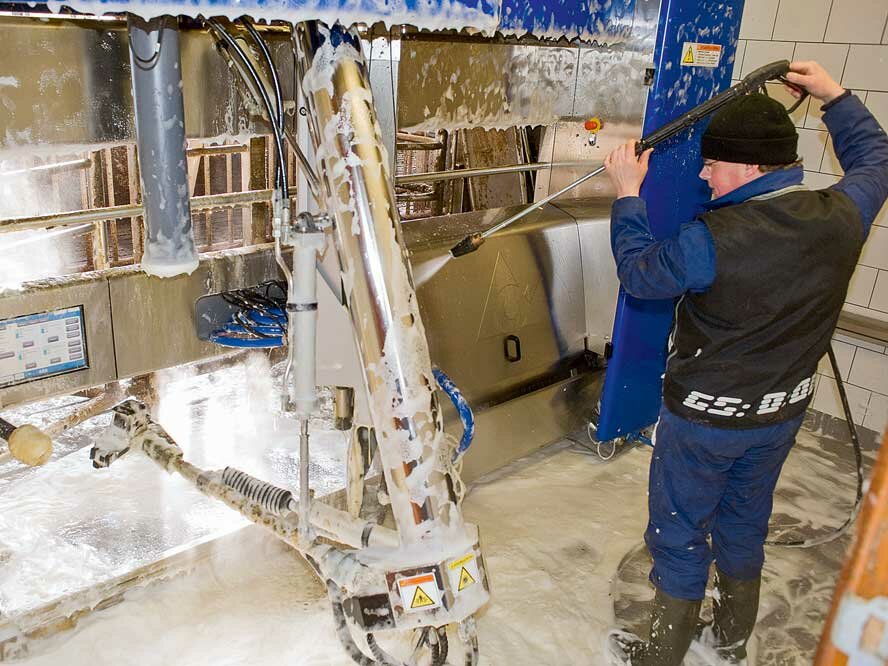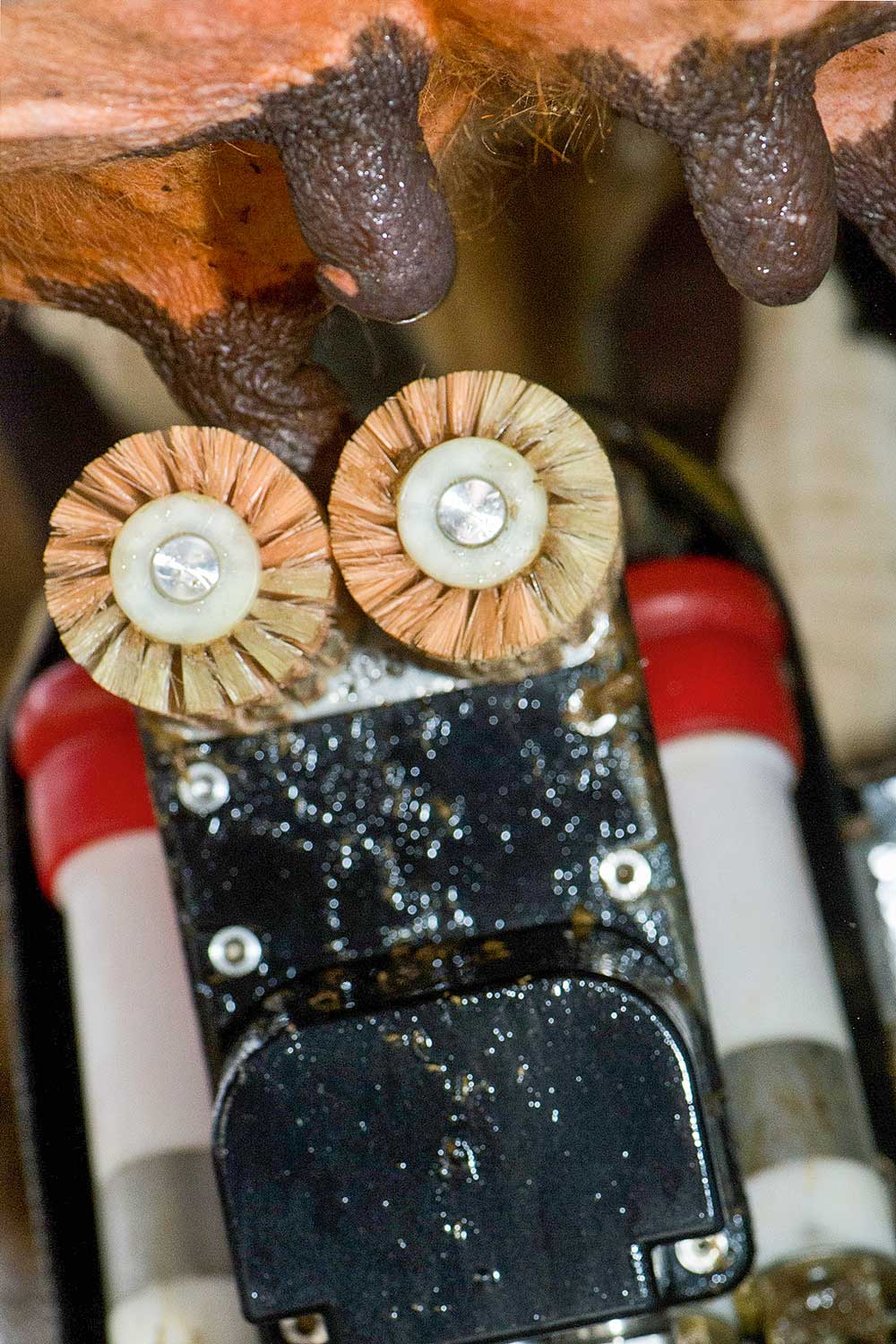Milking hygiene - Don't leave everything to the robot
By Claudia Bodensteiner, TU Munich, Dr Ulrike Sorge, Bavarian Animal Health Service, Prof. Dr Jörn Stumpenhausen, Weihenstephan-Triesdorf University of Applied Sciences
The milking robot is in continuous operation longer than any other milking system. In addition to milking, the Automatic Milking System (AMS) also cleans the system.
But even with high utilisation of the AMS, there is usually not a continuously constant flow of milk. Due to the often long breaks between the individual milkings, milk residues can dry in the milk-bearing parts and cause a critical multiplication of microorganisms. This is especially true if there is an intermediate cleaning time of more than eight hours. Udder health and milk hygiene problems can be the result.
High bacteria concentrations in milking robots
While the germ content of Bavarian dairy farms with conventional milking systems averaged 13,000 colony-forming units per ml (cfu/ml) of milk between January 2012 and May 2020, farms with AMS had average germ contents of 19,000 cfu/ml. As a quality criterion for raw milk, the microbial count is an essential indicator of the hygiene of milk production. The main influencing factors are the cleanliness of the extraction facilities, proper storage and transport of the milk and the udder health of the cow. An insufficiently cleaned and disinfected inner surface of milking machines, pipelines and tanks poses the greatest risk of contamination during machine milking. Contaminated milk-carrying pipes and surfaces are assumed to be the cause of 70 to 80 % of the germ content in raw milk.
How effective is the cleaning of automatic milking systems?
The Weihenstephan-Triesdorf University of Applied Sciences, in collaboration with the Tiergesundheitsdienst Bayern e.V. (Bavarian Animal Health Service), the Milchprüfring and with financial support from "milch.bayern", conducted a scientific study to record the hygiene status of AMS on Bavarian dairy farms. For this purpose, random sample analyses were carried out on twelve practical farms after each cleaning run. The aim was to investigate whether the four market-leading manufacturers differ from each other with regard to the effect of the main cleaning and the resulting germ content in the milking system. In addition, it was to be clarified whether the different measuring points have an influence on the expression of this criterion.
The investigations carried out mainly included bacteriological swab sampling immediately after the main cleaning. In addition, temperature and detergent measurements were carried out and - where possible - water and detergent consumption were recorded. The length of the milk pressure line and the age of the liner in use were also determined as possible influencing factors. A sensory test at the sampling points of the swabs served to record obvious cleaning problems.
Hygiene checklist for the milking robot
Successful milking robot farms have udder health under control not only through regular monitoring of the robot, but also through consistent hygienic preventive measures. Regardless of which milking robot brand you have in your barn, you should incorporate these routine measures into your operational procedures. This will reduce the likelihood of udder health problems in your dairy herd:
- Three main cleanings per day (eight-hour interval),
- Filter change after each main cleaning,
- Operation of the AMS exclusively with cleaning agents according to the manufacturer's instructions,
- Checking the detergent consumption,
- Keep the length of the transport line from the robot to the tank short,
- Adherence to the replacement interval of the teat rubbers,
- Observe water temperature during main cleaning,
- regularly take swab samples and tank milk samples (for bacteria count differentiation) and have them analysed.
Some of the bacterial counts were very high
Compared to conventional milking systems, the complexity of the AMS makes access to the swab sampling points within the milking system more difficult. (Overview 1).
In addition, there were large differences between the manufacturers regarding the design-related effort for targeted sampling, and not all defined sampling points could be reached with all milking robots investigated.
For sampling points 10 to 12, swab samples could only be obtained on some farms.
No sterility after cleaning
In none of the farms examined was the AMS able to show complete sterility at all sampled milk-bearing points after the cleaning run. Of the total of 266 swab samples taken, 38 were germ-free, which corresponds to a proportion of 14.3 %. Eleven different bacteria of importance to the dairy industry were detected in the laboratory. In addition to dirt germs, coagulase-negative staphylococci, aerobic spore-formers, asculin-negative or positive streptococci, Staphylococcus aureus, the most important udder-associated mastitis pathogen, was also detected in one farm. Coliforms, Enterobacteriaceae and Pseudomonas aeruginosa were also present, sometimes in high levels (+++). Furthermore, yeasts and moulds were found in individual cases.
Conform to cleaning parameters
Brand-related differences can first be seen at measuring points 1 to 4 (teat rubbers). However, the application times (number of milkings) at the study farms were in part very clearly above the manufacturer's recommendations. Even if large farm-specific differences occurred at measuring points 5 to 9, the farmers have hardly any influence on the cleanliness of the milking system at these points, except through the choice of the correct and suitable cleaning agent.
There was a tendency for the boiling water cleaning system to show advantages in cleaning efficiency in the systems investigated. However, in some of the other systems, the specified quantities for cleaning agent and water quantity were not adhered to. In the future, additional sensor technology could facilitate the monitoring of the correct course of the cleaning process and alert the farmer in case of malfunctions.
The results from these study farms show that the germ load after sampling tended to be lower, regardless of the manufacturer of the AMS, if all or almost all cleaning parameters were adhered to according to the specification.
Hygiene deficiencies
The measured bacterial counts characterise clear hygiene deficiencies that can be traced back to insufficiently cleaned inner surfaces of the milk-bearing components. All micro-organisms found on teat rubbers can also have a negative effect on the udder health of the cows. In addition, the quality of the raw milk is negatively affected and the germ content in the milk delivered increases.
A regular check whether the required amount of detergent and disinfectant has been sucked into the detergent containers (e.g. weekly mark on the canister) and whether a sufficient return temperature of the cleaning water has been maintained. In addition, a regular visual inspection of the milk-conducting components of the milking system by the farm manager is mandatory, as this allows quick and easy conclusions to be drawn about possible germ contamination.
The liner change interval specified by the manufacturer must be consistently adhered to. In addition, the farmer should regularly check the liner for germ contamination by taking swab samples between the intervals in order to be able to react immediately if necessary.
Conclusion
The cleaning function is basically available on all the milking robots examined. However, the farmer must continue to explicitly check whether the functionality is actually given. In addition to on-site checks, either regular swab samples or the differentiation of germs in the tank milk (e.g. detection of heat-resistant germs) should be carried out in order to be able to eliminate deviations at an early stage. The introduction of a regular cleaning check or even a seal of quality for automatic milking systems is also worth considering. The total bacterial count of the tank milk alone is not meaningful when it comes to the cleanliness of the milking system.
The results of this trial show clearly derivable tendencies with regard to the germ content after cleaning. With the help of sensor technology, the farmer must be better supported by the manufacturer in order to prevent continued operation with insufficient cleaning and disinfection.





